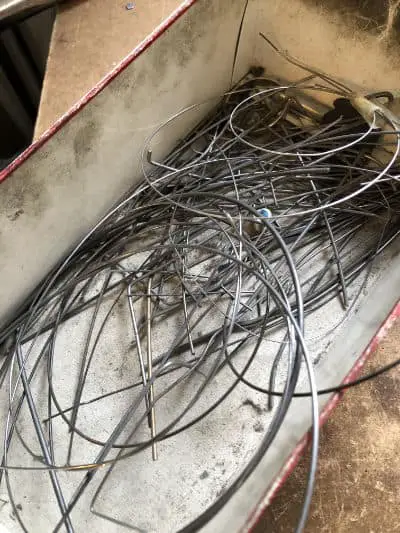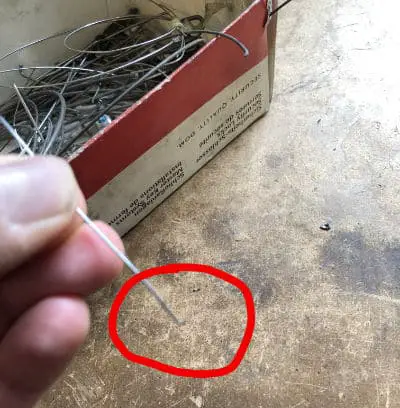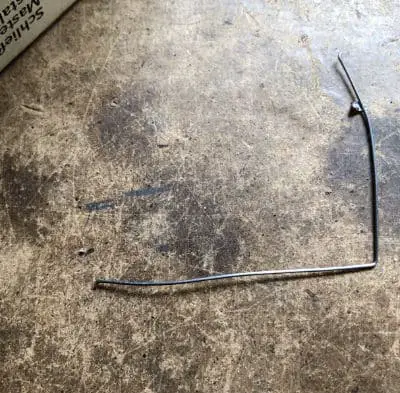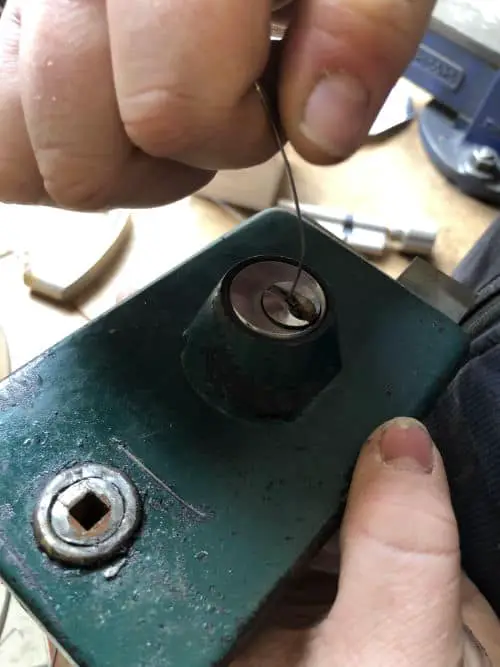It has happened… I was in a hurry and broke my key into my lock. The lock had been hard to close for a couple of months. I knew I had to do something but just pushed it to the day after. But now it is too late: I have a piece of a key in my hand and another inside the lock, preventing any action with another key. It is hard not to panic when you can’t enter your home.
What to do to extract a broken key from inside a lock? 1. Make sure the lock is at its default (locked) position. 2. Try first to extract the key with tweezers. 3. If you can’t reach the broken key, try with thin steel wire (guitar string) with a kind of hook at the end. 4. Apply some lubricant to help.
Those tips should be enough to get the key out. Once the key is out, you can use a spare. But if you don’t have one, with the two pieces of the broken key, a good locksmith (or hardware store) could manage to make a working copy of it.
It is important to understand how a lock works (or at least its cylinder) to manage to extract the broken key easily. These are the steps above with all the details to be executed properly.
1) Do NOT put glue on your key
This is an idea many people have, unfortunately. It looks simple: you put some extra strong glue at the tip of your broken key, you put it in the lock, pull, and, magically, the broken piece will go out…
Not so fast. Remember that pins and corresponding springs will resist and prevent the piece to slide out (you need much more force to overcome those springs pressure than the glue is capable of).
Worse, you have just pushed the broken key deeper inside the lock, making it harder to extract.
Even worse, some glue has spread inside the lock, blocking its mechanism, pins and springs are now glued together. Your lock is dead.
Now you need to call a professional to drill the lock, it will be harder, longer and more expensive.
That is why you should NEVER put glue on the tip of your broken key. Do the following instead.
2) Put the lock in its original position
Remember, you can insert your key in your lock in one and only position. Then you do a whole turn (say from closed to open) and you can take the key out. You can do a second turn and take the key out again. But you can’t take the key out when the turn is not complete. You can’t take the key out after 1/4 of a turn or 1/2 of a turn. If you pull, the key will stay inside the lock anyway. That is a way to close the door: you insert your key inside the lock and start to turn, pull the door close, close the lock by finishing the turn, and then take your key out.
Now you must have understood the most important point: when you break a key, you apply a force, that is to say, you have initiated a turn, usually 1/4 to 1/2 of a turn. The broken key will never be extracted at this position, no more than the unbroken one.
You will HAVE TO turn the key to its default position in order to take the broken piece out.
That alone is the single reason why most people can’t take the key out.
The lock will turn, because the broken key inside will act as a key, allowing the rotor of the lock to turn. But you will miss the part of the key to initiate the turn. You need to turn without pushing the broken piece deeper.
Usually, a turn with the point of a screwdriver or a knife. I apply pressure on the side of the profile (as opposed to pushing) to prevent pushing the piece further inside the lock. If the lock turns freely as it should, you can take advantage of it and open the lock in order to get into your house or apartment! If you don’t want to take the risk and do two turns of your lock, then you must be wise because it is risky.
Push or pull the door (accordingly in function of your door as you are used to operating it) in order to prevent any friction on the lock and make the move as smooth as possible.
When you have found the default position of your lock, you can start to extract the broken key.
3) Extract with tweezers.
If some small part of the key sticks out of the lock, try to grab it with tweezers, usually it works straightforwardly. Put some lubricant inside the lock to help with friction. Try with some hammer hits on the lock (gently of course): you can gain some millimeters out.
If you are lucky, this is the only thing you will have to do.
4) Extract with a special lock pick, a steel wire or a paper clip
If the key is too deep in the lock, tweezers will be of no help because you won’t be able to grasp the edge.
This is the difficult part, and it might not work every time.
Be patient and take your time. Even professionals don’t manage to do it instantly as it requires focus and patience. Remember that cinema and real life are different realities…
If you can get a special lock pin with a head in the shape of a hook, very good. Try to put it on top of the key in the free (small) space remaining between the key and the pins. This will grab your key and slowly take it out. Remember that the 4 or 5 or 6 pins with their respective spring will offer a resistance each step out. This key extractor set from Amazon is perfect for such a job. It is compact and has 4 extractor blades (2 saw and 2 extractor blades of different diameters).
But you may not have such a lock pick on you. Or the lock pick is too high (though thin) to fit in the free space between the key and the pins. Then, you have to use another tool.
The best tool is a steel wire such as a small piano string or guitar string. The diameter is small enough to fit in really tight spaces. But this is not it. When you cut a small portion of the wire (3 to 4 inches) with the wire cutter, try to make a small hook at the end. Do not make a clean cut. If you are not happy with your hook, try again and cut further. This hook will grab the key at the end of the cylinder and it is important to make it properly.
This method is longer than using tweezers but if you have no other choice, this is the only way you can manage to extract the key without the help (price, time and hurdle) of a professional. That is to say: be patient, this is worth it.
5) If you can turn the lock to open the door
Then you will be able to disassemble the lock and:
- hit gently the lock on a hard surface to make the broken key go out slowly, this might work ok if the lock, again, is in its default position (see above),
- when the lock is disassembled, you can see the other end of the cylinder. Then, you can PUSH the broken key all the way through and extract it from behind, reassemble and voilà!
- if you don’t feel you’re capable of doing it yourself, you can bring the lock to a locksmith or hardware store (or that nice neighbor) and have it extracted for you. A locksmith will cut another key for you as well with the two broken parts and you will be good to go.
It is always better to remove a broken key without disassembling the lock as it is way quicker and less prone to mistakes. So my advice to you is to always try longer to extract the key without disassembling as it will be quicker and easier in the end: you’re done.
Preventing 1: Do not play or work with a key
How to avoid breaking the key in the first place? Well, if you have read why a key can’t go into a lock, we have covered many ways of damaging a key.
Well basically, do NOT use your key as a tool to drill a hole, to cut something, to open a box as a lever, to open a can, to open a door and so on… We all have our keys in our pocket at all times and the temptation is high to use them to other purposes than opening a lock. Now, I have understood that I shouldn’t do that and I consider a key as a fragile, precise and important object.
Remember that when a key is bent once, even if you have it straight, it will remain fragile. Use a spare a soon as possible because it will be prone to break. Do not take the risk and use a damaged key, otherwise, you might regret it. The first and better way of extracting a broken key from a lock is not having to do so in the first place. Change your key as soon as you believe it needs to.
Preventing 2: Make sure the lock works properly
If your lock is hard to turn, then there is a risk to break a key. Try to maintain your lock in a good working condition by:
- making sure there is enough lubricant in the cylinder,
- making sure there is enough lubricant in the lock itself (you can spray some WD40 from the side of the door inside the mechanism);
- making sure the lock is properly aligned with the jamb. If the latch rubs the jamb because of misalignment, then the additional force required to open the lock can make the key to break. The door can be too low or can swell because of humidity. The quickest remedy to that problem is to enlarge the hole in the jamb with a wood rasp.
If your door and lock are properly maintained, that can save you a lot of hassle. Your lock will function well for a long time, will be less prone to wear, let alone break a key. This is worth it. You will save a lot of money and worries.
Preventing 3: Do not leave your key inside your lock
If you need both hands to carry something, do not leave your key in your lock. More often than not someone will hit the key and might get hurt. The side effect is the key will be broken inside the lock. It is common as well to open the door, to leave the key inside the lock with the bunch of keys hanging. Then you come inside your house or apartment carrying big bags or boxes… Spoiler alert: your key will be soon broken because it is on your way. So always take your key out of the lock when you are finished with it.
Conclusion
Take great care of your key and lock. They will last longer. If you break your key inside your lock, first try to extract with tweezers. If it doesn’t work, try with steel wire with some kind of hook at one hand. You should manage to take to broken piece out. A good locksmith can make a copy of the two parts. Use a spare key as soon as you feel your key is fragile. And always, even if you are in a hurry, do not open or close your door brutally.






